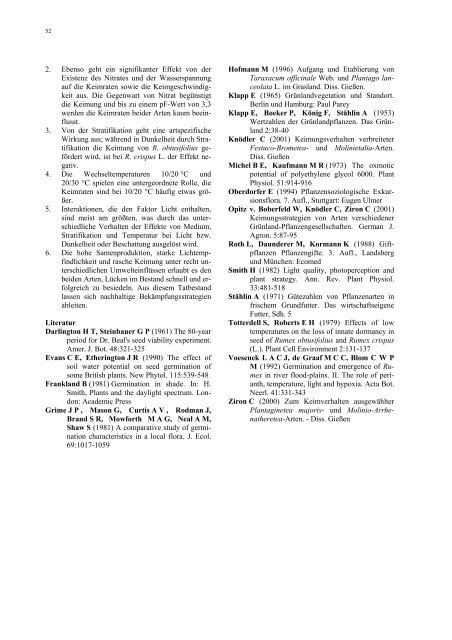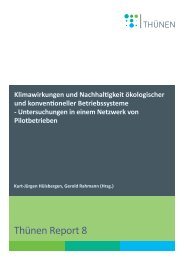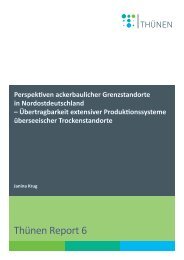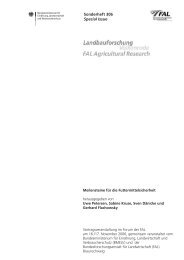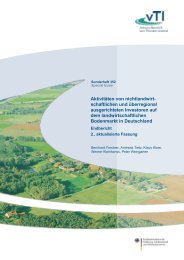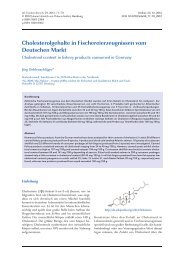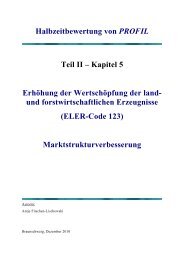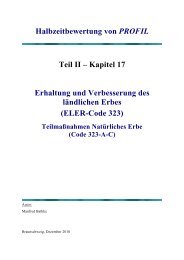Sonderheft 255 Special Issue - Johann Heinrich von Thünen-Institut
Sonderheft 255 Special Issue - Johann Heinrich von Thünen-Institut
Sonderheft 255 Special Issue - Johann Heinrich von Thünen-Institut
Sie wollen auch ein ePaper? Erhöhen Sie die Reichweite Ihrer Titel.
YUMPU macht aus Druck-PDFs automatisch weboptimierte ePaper, die Google liebt.
52<br />
2. Ebenso geht ein signifikanter Effekt <strong>von</strong> der<br />
Existenz des Nitrates und der Wasserspannung<br />
auf die Keimraten sowie die Keimgeschwindigkeit<br />
aus. Die Gegenwart <strong>von</strong> Nitrat begünstigt<br />
die Keimung und bis zu einem pF-Wert <strong>von</strong> 3,3<br />
werden die Keimraten beider Arten kaum beeinflusst.<br />
3. Von der Stratifikation geht eine artspezifische<br />
Wirkung aus; während in Dunkelheit durch Stratifikation<br />
die Keimung <strong>von</strong> R. obtusifolius gefördert<br />
wird, ist bei R. crispus L. der Effekt negativ.<br />
4. Die Wechseltemperaturen 10/20 °C und<br />
20/30 °C spielen eine untergeordnete Rolle, die<br />
Keimraten sind bei 10/20 °C häufig etwas größer.<br />
5. Interaktionen, die den Faktor Licht enthalten,<br />
sind meist am größten, was durch das unterschiedliche<br />
Verhalten der Effekte <strong>von</strong> Medium,<br />
Stratifikation und Temperatur bei Licht bzw.<br />
Dunkelheit oder Beschattung ausgelöst wird.<br />
6. Die hohe Samenproduktion, starke Lichtempfindlichkeit<br />
und rasche Keimung unter recht unterschiedlichen<br />
Umwelteinflüssen erlaubt es den<br />
beiden Arten, Lücken im Bestand schnell und erfolgreich<br />
zu besiedeln. Aus diesem Tatbestand<br />
lassen sich nachhaltige Bekämpfungsstrategien<br />
ableiten.<br />
Literatur<br />
Darlington H T, Steinbauer G P (1961) The 80-year<br />
period for Dr. Beal's seed viability experiment.<br />
Amer. J. Bot. 48:321-325<br />
Evans C E, Etherington J R (1990) The effect of<br />
soil water potential on seed germination of<br />
some British plants. New Phytol. 115:539-548<br />
Frankland B (1981) Germination in shade. In: H.<br />
Smith, Plants and the daylight spectrum. London:<br />
Academic Press<br />
Grime J P , Mason G, Curtis A V , Rodman J,<br />
Brand S R, Mowforth M A G, Neal A M,<br />
Shaw S (1981) A comparative study of germination<br />
characteristics in a local flora. J. Ecol.<br />
69:1017-1059<br />
Hofmann M (1996) Aufgang und Etablierung <strong>von</strong><br />
Taraxacum officinale Web. und Plantago lanceolata<br />
L. im Grasland. Diss. Gießen.<br />
Klapp E (1965) Grünlandvegetation und Standort.<br />
Berlin und Hamburg: Paul Parey<br />
Klapp E, Boeker P, König F, Stählin A (1953)<br />
Wertzahlen der Grünlandpflanzen. Das Grünland<br />
2:38-40<br />
Knödler C (2001) Keimungsverhalten verbreiteter<br />
Festuco-Brometea- und Molinietalia-Arten.<br />
Diss. Gießen<br />
Michel B E, Kaufmann M R (1973) The oxmotic<br />
potential of polyethylene glycol 6000. Plant<br />
Physiol. 51:914-916<br />
Oberdorfer E (1994) Pflanzensoziologische Exkursionsflora.<br />
7. Aufl., Stuttgart: Eugen Ulmer<br />
Opitz v. Boberfeld W, Knödler C, Ziron C (2001)<br />
Keimungsstrategien <strong>von</strong> Arten verschiedener<br />
Grünland-Pflanzengesellschaften. German J.<br />
Agron. 5:87-95<br />
Roth L, Daunderer M, Kormann K (1988) Giftpflanzen<br />
Pflanzengifte. 3. Aufl., Landsberg<br />
und München: Ecomed<br />
Smith H (1982) Light quality, photoperception and<br />
plant strategy. Ann. Rev. Plant Physiol.<br />
33:481-518<br />
Stählin A (1971) Gütezahlen <strong>von</strong> Pflanzenarten in<br />
frischem Grundfutter. Das wirtschaftseigene<br />
Futter, Sdh. 5<br />
Totterdell S, Roberts E H (1979) Effects of low<br />
temperatures on the loss of innate dormancy in<br />
seed of Rumex obtusifolius and Rumex crispus<br />
(L.). Plant Cell Environment 2:131-137<br />
Voesenek L A C J, de Graaf M C C, Blom C W P<br />
M (1992) Germination and emergence of Rumex<br />
in river flood-plains. II. The role of perianth,<br />
temperature, light and hypoxia. Acta Bot.<br />
Neerl. 41:331-343<br />
Ziron C (2000) Zum Keimverhalten ausgewählter<br />
Plantaginetea majoris- und Molinio-Arrhenatheretea-Arten.<br />
- Diss. Gießen


